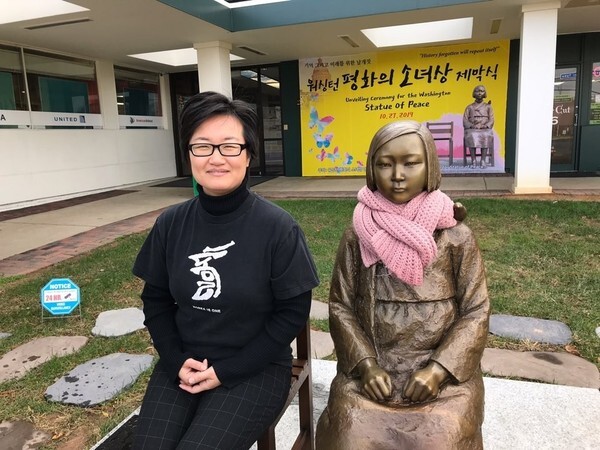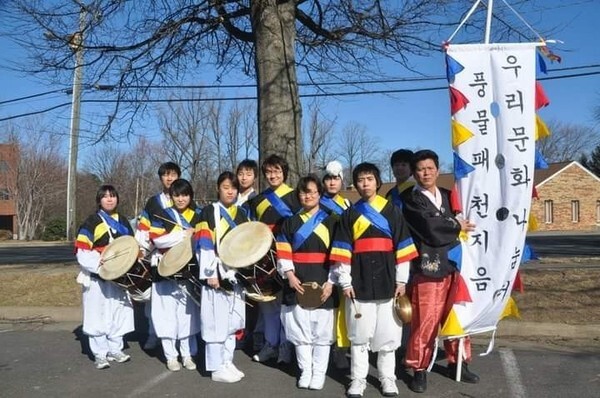hankyoreh
Links to other country sites 다른 나라 사이트 링크
[Interview] A Korean-American working for peace on the Korean Peninsula

There’s an organization called Washington Butterfly for Hope whose 20 or so members are Korean-Americans living around the US capital of Washington, DC. The organization was set up in January 2016 by Korean-Americans who’d protested in front of the Japanese Embassy in Washington against the comfort women agreement reached by the South Korean and Japanese governments at the end of 2015.
“The day after the agreement was announced, a local publication for Korean-Americans gave a lot of coverage to a former activist with the Washington Coalition for Comfort Women Issues who came out in support of the agreement. That’s the point when I decided we needed an organization of our own,” said Hyunsook Cho, president of Washington Butterfly for Hope.
In the first year of its establishment, the group put together an exhibition about the history of the comfort women at George Mason University in Virginia. Last month, after three years of effort, the group managed to erect a comfort woman statue in Annandale, a town in Virginia’s Fairfax County, near Washington. It was the fifth comfort woman statue to go up in the US. The Hankyoreh spoke with Cho on the phone on Nov. 19.
Although the Annandale comfort woman statue arrived in the US in November 2016, it took two years and 11 months for it to find a permanent home.
Symbolic value of erecting statue near US capital“Yoon Mi-hyang, president of the Korean Council for Justice and Remembrance for the Issues of Military Sexual Slavery by Japan, came up with the idea in March 2016. She asked me what I thought about erecting a statue in Washington, DC, given the US capitals’ symbolic value. Butterfly-shaped benches had already been set up in honor of the comfort women in Virginia, on the grounds of the Fairfax County office,” Cho said.
After that, Cho paid four visits to the Washington city hall. “During a meeting with the chief of the city’s Asia-Pacific bureau, I asked if there was any extra space in one of the city’s parks or around Chinatown to set up the comfort woman statue. I really wanted to set up a statue in the US capital. But the bureau chief wouldn’t give me a definite yes or no. And then someone else was put in that position.”
In 2017, the group reached an agreement with Salisbury University to erect the statue on its campus and even settled on a date, but that plan ultimately fell through. “We got a letter from the university officially stating that they would be honored to host the comfort woman statue and that it would help their students learn about history. But then later they told us they couldn’t do it, without even giving us a reason,” Cho said.
While it wasn’t the group’s first choice, the comfort woman statue eventually found a home in a Korean-American community near Washington. “The coalition joined us this year in working to erect the comfort woman statue. On Liberation Day [Aug. 15] this year, we took the statue out of storage and sent it on a brief ‘outing’ to Washington. As a result, we were put in touch with a Korean building owner in Annandale who was willing to host the statue on his property,” Cho said.
The building next to the comfort woman statue also contains a “space of remembrance.” “The room isn’t big, of course, but it contains a detailed explanation of the comfort woman statue and various badges and armbands. A Korean who runs a printing shop gave us about a quarter of his shop for the exhibition.”
Since the statue was unveiled, it continues to be visited by Korean-Americans, Cho says. “Someone who works within sight of the comfort woman statue said there’s always someone in front of the comfort woman statue. Koreans take care of the statue as they pass by. They clean off any bird droppings and put an umbrella over it when it rains.”
The group hasn’t given up its efforts to set up a comfort woman statue in Washington, and it has its sights set on next year. “Since the beginning of this year, we’ve been contacting the mayor’s office, universities, and churches to find a place for the statue. A school is the best option, but based on recent experience, I don’t think it would be a problem to use privately owned land either.”

Cho first set foot on American soil with her family in 1990, at the age of 12. “I’m a single mom, raising a five-year-old and a 13-year-old. I work part-time at a travel agency. I also drive an Uber and work as an interpreter.”
Cho says that the goal of her activism is Korean unification. “In June, I visited Congress with members of NAKA [the National Association of Korean Americans] to support a resolution to end the Korean War that was submitted by Ro Khanna, a US representative with the Democratic Party. In order to convince more representatives to support the resolution, NAKA set aside a day last month for Koreans to focus their phone calls and letters on their local member of Congress. We’re communicating our desire for peace on the Korean Peninsula.”
Cho’s activity is inspired by her keen fondness for Korean culture. “Even now, I take part in a pungmul club every Monday. My younger daughter likes drumming so much that I always take her with me,” she says.
Cho learned about pungmul, a Korean style of folk music that includes percussion, dancing, and singing, when she was in the eighth grade, back in 1992.
“High school students set up a pungmul club that they called ‘Korean Culture Sharing Space.’ American schools have an event called ‘International Day’ when multicultural students participate in a talent show. We set up the pungmul club so that we could learn samulnori [music performed on four drums] and put on a show. While doing pungmul, I naturally did a lot of thinking about my identity as a Korean-American. Then there were the LA riots in 1992, and I thought a lot about the identity of the Korean immigrants who were trapped between the blacks and whites. After that, I learned a lot about the history of immigration and Korea’s modern history from older kids who’d gone to university in Korea.”
Visited Korea in 2001, saw Korean War sites and large-scale demonstrationsIn 2001, Cho visited her homeland with other US peace activists and went to see Maehyang Village, site of a US military firing range, and Nogeun Village, where civilians were massacred during the Korean War.
“That was when I first saw the large-scale demonstrations in Gwangju,” she explained. “As I was interpreting, I thought there was something the 1.5 generation of immigrants could do for peace on the Korean Peninsula.”
In 2004 and 2005, she attended specialized pungmul courses in South Korea. “I studied in Gwangju while I was staying there for three months in 2004. The following year, I did three weeks of studies in the Imsil Pilbong style of folk music.”
While she is originally trained as a drummer, Cho now plays the gong.
“Of the 10 members in the pungmul band, most are in their 20s. Two of them are adoptees,” she explained. “With something like a fan dance or salpuri [traditional exorcism rite] performance, you have to spend a long time studying. I really like pungmul because it’s easy to learn to do it yourself.”
What significance does peace on the Korean Peninsula hold to a Korean living across the Pacific in the US?
“I’m also a Korean,” Cho said. “I have roots in Korea. Even now, Americans ask me if I’m ‘South Korean or North Korean,’ since it’s a divided country.”
“As a US citizen, I would welcome there not being the threat of war. The US spends a lot of money on its military, and that’s my taxpayer money,” she added. “We need to end war for the sake of ultimate peace.”
Cho also stressed the importance of educating US politicians regarding peace on the Korean Peninsula.
“Among the Koreans involved in grass-roots campaigning for reunification in the US right now, there are worries that if North Korea-US relations keep going the way they are now, we could end up back where we were two years ago with [US President Donald] Trump talking about ‘fire and fury,’” she said.
By Kang Sung-man, senior staff writer
Please direct comments or questions to [english@hani.co.kr]

Editorial・opinion
![[Column] Season 2 of special prosecutor probe may be coming to Korea soon [Column] Season 2 of special prosecutor probe may be coming to Korea soon](https://flexible.img.hani.co.kr/flexible/normal/500/300/imgdb/original/2024/0426/3317141030699447.jpg) [Column] Season 2 of special prosecutor probe may be coming to Korea soon
[Column] Season 2 of special prosecutor probe may be coming to Korea soon![[Column] Park Geun-hye déjà vu in Yoon Suk-yeol [Column] Park Geun-hye déjà vu in Yoon Suk-yeol](https://flexible.img.hani.co.kr/flexible/normal/500/300/imgdb/original/2024/0424/651713945113788.jpg) [Column] Park Geun-hye déjà vu in Yoon Suk-yeol
[Column] Park Geun-hye déjà vu in Yoon Suk-yeol- [Editorial] New weight of N. Korea’s nuclear threats makes dialogue all the more urgent
- [Guest essay] The real reason Korea’s new right wants to dub Rhee a founding father
- [Column] ‘Choson’: Is it time we start referring to N. Korea in its own terms?
- [Editorial] Japan’s rewriting of history with Korea has gone too far
- [Column] The president’s questionable capacity for dialogue
- [Column] Are chaebol firms just pizza pies for families to divvy up as they please?
- [Column] Has Korea, too, crossed the Rubicon on China?
- [Correspondent’s column] In Japan’s alliance with US, echoes of its past alliances with UK
Most viewed articles
- 1‘We must say no’: Seoul defense chief on Korean, USFK involvement in hypothetical Taiwan crisis
- 2[Column] Season 2 of special prosecutor probe may be coming to Korea soon
- 3N. Korean delegation’s trip to Iran shows how Pyongyang is leveraging ties with Moscow
- 4Amnesty notes ‘erosion’ of freedom of expression in Korea in annual human rights report
- 5Korea sees more deaths than births for 52nd consecutive month in February
- 6[Reportage] On US campuses, student risk arrest as they call for divestment from Israel
- 7[Editorial] New weight of N. Korea’s nuclear threats makes dialogue all the more urgent
- 8‘Weddingflation’ breaks the bank for Korean couples-to-be
- 9Division commander ordered troops to enter raging flood waters before Marine died, survivor says
- 10[Editorial] Korea’s surprise Q1 growth requires objective assessment, not blind fanfare